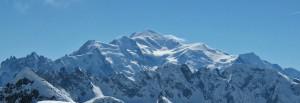
Mont Blanc, Les Aiguilles Rouges in the foreground
We often get the following question before people book a guided Mont Blanc ascent with us:
- How hard is it?
- How much preparation and acclimatization do I need?
- How do I train for climbing Mt Blanc?
What can I expect?
Depending on who you ask, you might get widely different answers regarding the difficulties to climb Mt Blanc. Searching information on the internet, you might imagine everything between an easy walk to a complicated and exhausting climb. Probably this is because if you ask the “climber” – the ascent is a walk, but if you ask the “walker” – the ascent is a climb!
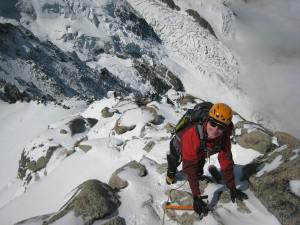
Mixed terrain preparation climb for Mt Blanc
We would say the normal routes up Mont Blanc are mostly walking and scrambling in very exposed terrain, what ever route you take there are places where you will have to use your hands. During those section we are always roped up.
One thing is for sure – it is physically very demanding to climb Mt Blanc. We have done more than a lot of Mt Blanc ascents, with many different kinds of people, and we always ask afterwards if they found it easy? Never ever have we heard anyone say it was easy! But 2 weeks later, home among friends and family, it might of course sound (and feel) completely different…
90% of the people climbing Mt Blanc with us choose the 5-day Mt Blanc course, where we climb with a maximum of 2 persons per guide. This gives us the option to do more technical and more fun climbs during the acclimatization period, and also prepares you better technically for the summit climb then a more walking-orientated program would do. A 5-day program is the shortest period of acclimatization that gives most people a good possibility to reach the summit.
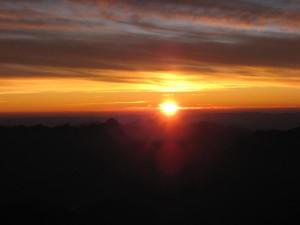
Sunrise captured from Mt Blanc du Tacul
Concretely this week involves 5 days of climbing in altitude and 2 nights in mountain huts. On the 3 preparation days we climb a different summit every day, working out in altitude for about 6 hours a day. For the actual ascent of Mt Blanc we normally start early in the morning (way before sunrise) from the hut and walk for 10-14 hours (more or less non-stop) until we are back at the cable car. So obviously this demands a lot of endurance in both body and mind.
Every group booking with us is treated separately, which means every group gets their own private mountain guides. This also means we are very flexible. If we find out during the week that Mont Blanc is too hard, we can change our objective to an easier mountain.
How do I prepare myself?
If you come to Chamonix for a 5 or 6-day Mt Blanc course, be prepared for a very adventurous week where you will learn a lot! To have a good chance to reach the summit you need to already be a confident mountain walker with a good level of fitness. You do not need to have any previous climbing experience, but if you do, it will be easier for you. During the preparation days we learn and practice walking with crampons and ice axe on snow and ice, as well as scramble up and down on rock.
Building up your body strength for a week of mountaineering can be done by all sorts of endurance training. There is no specific training program, the more varied the better. Biking, walking on uneven trails, and ski touring are all good activities that can be done for many hours at the time. Climbing improves your coordination and balance, and get you used to heights.
How will my body cope with altitude?
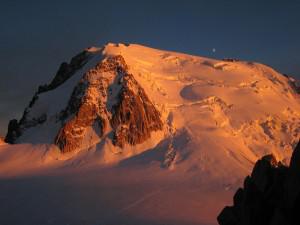
Sunrise on Mt Blanc du Tacul (4248m)
Going too quickly from sea level to high altitude (above 2000m) and staying over night, there is a large risk for getting head ache and feeling nauseous. By doing a climb over 3000m the first day, then spending a night in Chamonix town (1000m) we give the body a chance to adapt to altitude. It is important to understand that it is during the time of rest at lower altitude that the body has the energy to produce more red blood cells etc. It is the same principle as with all other physical training – overcompensation happens during recovery, not while exercising. Next we spend two days climbing, and one night, around 3600m, followed by a rest night in Chamonix. Then we attack Mont Blanc.
Since the lifts in Chamonix quickly take us up and down, we get the possibility to climb high peaks in just one day. Above 4000m is when it really stats to get hard in our experience, and therefore it is good to include a 4000m peak for acclimatization before going to Mt Blanc (4810m).
However everybody is different, and it is no way to say how you will cope with altitude before you have tried the experience. Often it is not the young and most fit who is the least affected by altitude.
What further skills do I need to climb without a guide?
Mont Blanc is a serious challenge, not to be underestimated. Additional to being a competent ice and rock climber you need to be an accomplished mountaineer with significant experience of high alpine terrain.
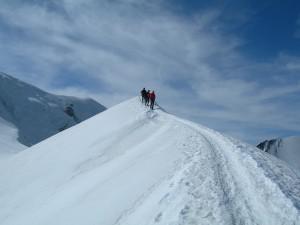
Coming down the Bosses Ridge from Mt Blanc
You need to be confident climbing with crampons and ice axe in exposed glaciated terrain, knowing how to use a rope to protect your party. The travel on glaciers demands competence in rope-work and crevasse rescue techniques. Further you should have experience of route finding and be able to determine the risk of alpine hazards, such as degrading weather trends, avalanches and serac falls. This obviously involves both knowing how to avoid and how to deal with the situation in case of an accident.
The programs we implement on our Mt Blanc courses are in general good for acclimatization. It is preferable to have a minimum of 5 days to climb Mt Blanc if you come to Chamonix from sea level – the more acclimatization you get, the easier the ascent of Mt Blanc will be for you. The climbs you can do for acclimatization totally depends on your level of mountaineering and climbing.
Note! Climbing Mt Blanc is dangerous, and this article is by no means a check list of skills that, if possessed, assures you safety on Mt Blanc. We take no responsibility for any non-guided ascents of Mt Blanc, nor are we by writing this post recommending anyone to go there without a guide.
If you would like to learn about alpine climbing and get feedback on the your capabilities as a mountaineer we recommend you to do a week-long mountaineering course with a private mountain guide.
Which route to climb?
The route via Dome de Goutier is a slightly shorter climb on the summit day then the “3-summits” route (from the Cosmique hut over Mt Blanc du Tacul, Mt Maudit to Mt Blanc), but therefore it is a longer approach to the hut the day before.
From the Cosmique hut the route-finding gets more difficult incase of low visibility, and if it is a lot of fresh snow it is not safe to walk up Mt Blanc du Tacul due to avalanche danger.
Conclusively, in our opinion, the Cosmique route gives you the nicer over-all experience.
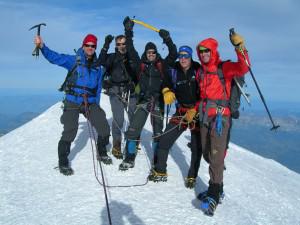
On the summit of Mt Blanc!

